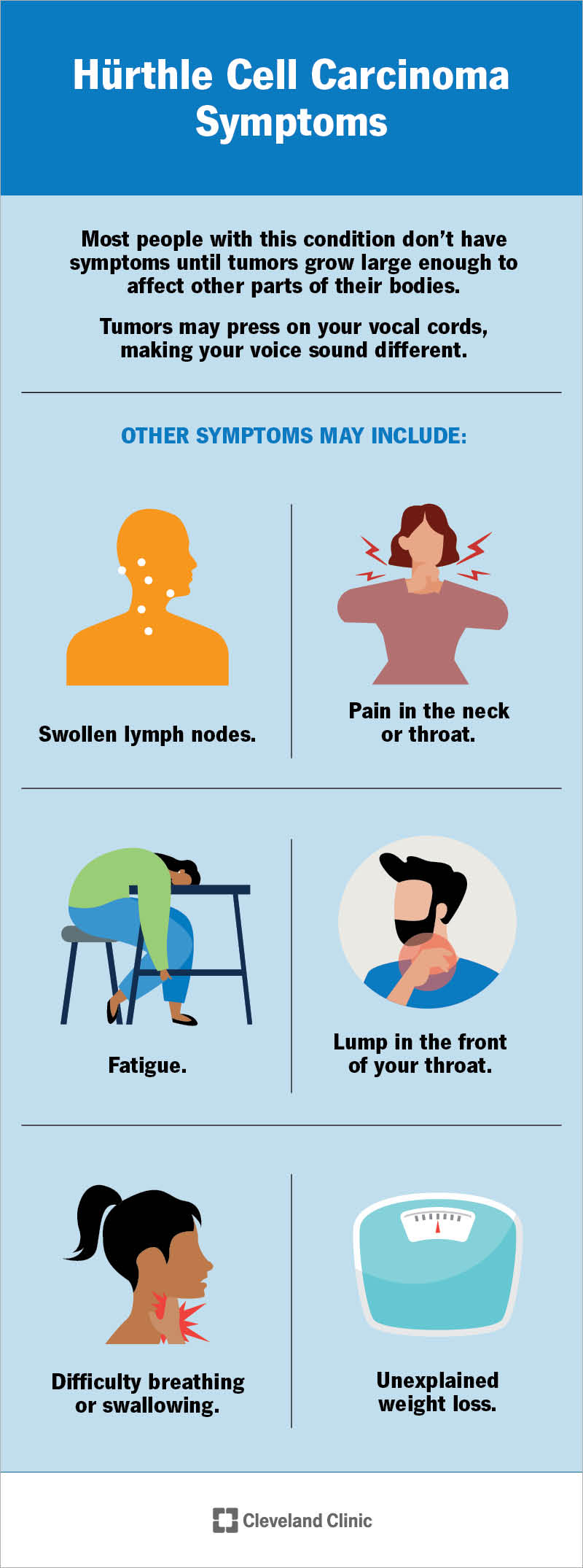Hürthle cell carcinoma is a rare, aggressive form of thyroid cancer. It causes tumors that may affect your ability to speak and breathe. Left untreated, it may spread to your lungs and bones. Healthcare providers treat this cancer with surgery to remove all or part of your thyroid.
Advertisement
Cleveland Clinic is a non-profit academic medical center. Advertising on our site helps support our mission. We do not endorse non-Cleveland Clinic products or services. Policy

Hürthle (pronounced “HEERT-luh” or “HER-THUL) cell carcinoma is a rare, aggressive form of thyroid cancer. Your thyroid is a small gland in the base of your neck. Your thyroid releases hormones that help regulate your metabolism. Hürthle cell carcinoma causes tumors that may affect your ability to speak and breathe. Left untreated, it may spread to other areas of your body, including your lymph nodes, lungs and bones. Healthcare providers treat this cancer with surgery to remove all or part of your thyroid.
Advertisement
Cleveland Clinic is a non-profit academic medical center. Advertising on our site helps support our mission. We do not endorse non-Cleveland Clinic products or services. Policy
People may have Hürthle cell carcinoma without noticing changes in their bodies. Some people are diagnosed after having tests for unrelated issues. When Hürthle cell carcinoma does begin to cause symptoms, they may start as lumps or bumps on your thyroid that make noticeable lumps on the front of your throat. As the tumors grow, they may press on your esophagus, making it hard for you to swallow, or on your trachea (windpipe) so you have trouble breathing. The tumor may press on your vocal cords, changing how you sound when you talk.
Noncancerous and cancerous Hürthle cell tumors may cause similar symptoms. Sometimes, healthcare providers can’t tell if a tumor is cancerous or noncancerous until they can examine tumor cells under a microscope.
Anyone can develop Hürthle cell carcinoma, but it’s more common among people ages 55 and older. Women are more likely to develop this condition.
No, it’s not. About 14 in 100,000 people are diagnosed with thyroid cancer annually. Hürthle cell carcinoma represents about 3% of all cases of thyroid cancer.
Most people with this condition don’t have symptoms until tumors grow large enough to affect other parts of their bodies. For example, tumors may press on your vocal cords, making your voice sound different. Other symptoms may include:
Advertisement
Medical researchers haven’t identified a specific cause, but they’ve found some risk factors that increase the chance you’ll develop this condition, including:
They diagnose this condition by doing a physical examination and asking about your symptoms, your medical history and your family medical history. Healthcare providers may do tests, including:
Healthcare providers use cancer staging systems to plan treatment. They stage Hürthle cell carcinoma with the TNM staging system. (T stands for tumor. N stands for lymph node involvement. M stands for metastasis, whether cancer has spread.) Hürthle cell carcinoma stages range from Stage I to Stage IV.
Healthcare providers also factor in people’s ages when staging Hürthle cell carcinoma. People who are ages 55 and younger when they’re diagnosed have Stage I Hürthle cell carcinoma, regardless of tumor size or tumor effect on lymph nodes. If tumors have spread to more distant lymph nodes or organs, people ages 55 and younger have Stage II cancer.
Advertisement
Surgery is the most common treatment for this condition. Depending on your situation, surgeons may remove all or part of your thyroid gland. They may also remove affected lymph nodes. Thyroid surgery may eliminate the cancer.
After surgery, you may receive medication that stops your thyroid from making hormones that increase the chance cancer will come back. Other treatments include:
Yes, it is. Surgery to remove all or part of your thyroid eliminates the cancer. If you have this surgery, you’ll take medication to replace your thyroid hormones.
A recent study showed 95% of people with this condition were alive five years after diagnosis. The same study showed 93% of people were alive 10 years after diagnosis.
Advertisement
There’s no sure way to reduce your risk. Some people develop this condition because they have a family history of thyroid cancer. If that’s your situation, talk to a healthcare provider about symptoms that may be signs of Hürthle cell carcinoma.
Depending on your treatment, you may need to take thyroid hormone replacement medication for the rest of your life. Hürthle cell carcinoma can come back. Ask your healthcare provider what symptoms may be signs your condition has come back.
Hürthle cell carcinoma is a rare type of thyroid cancer. If you have symptoms, healthcare providers may need to do thyroid surgery to confirm you have this condition. Surgery to diagnose the cancer often eliminates the issue. But surgery doesn’t solve all the issues Hürthle cell carcinoma may cause.
People who have thyroid surgery need to take hormone medication for the rest of their lives. And Hürthle cell carcinoma may come back after treatment. If you have this condition, please know you can count on your healthcare providers for support and help if Hürthle cell carcinoma returns.
Advertisement
Hearing you have cancer can be scary. But most thyroid cancer is treatable, and the providers at Cleveland Clinic are here to help.

Last reviewed on 10/14/2022.
Learn more about the Health Library and our editorial process.